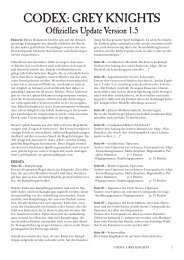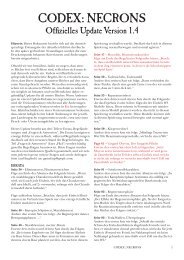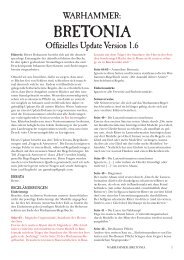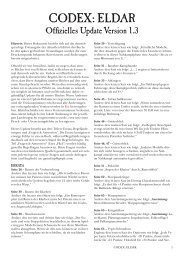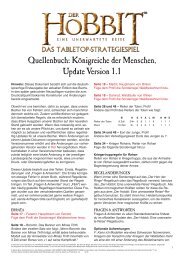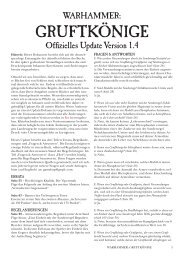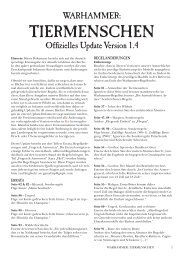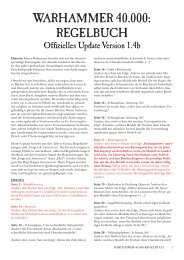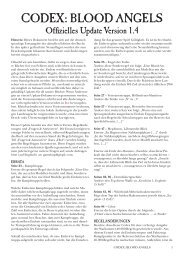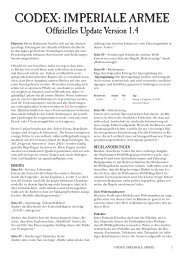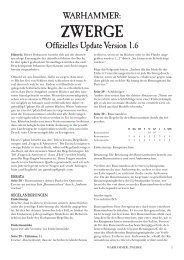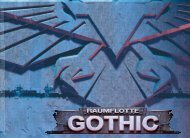Necromunda rulebook - Games Workshop
Necromunda rulebook - Games Workshop
Necromunda rulebook - Games Workshop
You also want an ePaper? Increase the reach of your titles
YUMPU automatically turns print PDFs into web optimized ePapers that Google loves.
SCENARIO 7: Shoot out<br />
In this scenario fighters from two rival gangs meet in<br />
a small wastezone settlement. The situation is tense<br />
because neither side wants to be seen breaking the<br />
peace. The locals hide behind closed doors, fearful<br />
that a firefight may develop. Meanwhile the fighters<br />
converge from opposite sides of the settlement. As<br />
they catch sight of each other they prepare to stand<br />
their ground, neither willing to give way, but not<br />
wishing to be seen drawing a weapon first. Soon they<br />
stand almost face to face, hands hovering above guns,<br />
eyes fixed intently upon their targets.<br />
The objective of the Shoot-out scenario is not to draw<br />
a weapon before your enemy. At the same time you<br />
must entice your rival to draw first and then drive<br />
him out of town with your return fire.<br />
TERRAIN<br />
The terrain represents a small wastezone settlement.<br />
Each player takes it in turn to place a piece of terrain,<br />
either a ruined building structure or a connecting<br />
walkway. It is suggested that the terrain is set up<br />
within an area 4' x 4' or thereabouts.<br />
THE GANGS<br />
Each player rolls a D6 to see how many of his gang<br />
are present for the shoot-out: 1-2 = 2 fighters, 3-4 =<br />
3 fighters, and 5-6 = 4 fighters. These fighters are<br />
randomly selected from the gang – the player cannot<br />
choose which of his fighters are involved in the<br />
shoot-out.<br />
The two gangs are set up 16" apart at ground level<br />
and in a position where they are in full view of each<br />
other. Roll a dice to decide which side sets up first.<br />
Each gang must set up in a small group with no<br />
model more than 1" away from any other model.<br />
All fighters are assumed to have their weapons<br />
holstered or slung at the start of the game. Until a<br />
weapon is drawn a special build-up and fast draw<br />
sequence of play is used.<br />
119<br />
NECROMUNDA<br />
Settlements of any significant size are regarded as neutral territory by gang fighters and other Underhivers<br />
alike. The Guild traders take a dim view of gangs who bring their disputes into town – especially when<br />
innocent customers get hurt and property damaged. Existence in the Underhive is precarious enough without<br />
the added danger of rampaging gangs using local settlements as battlegrounds. Only outlaw gangs pay no<br />
heed to this unwritten code, shooting up settlements, killing Underhivers and robbing drinking holes.<br />
THE BUILD-UP<br />
The build-up to a shoot-out is a tense affair. To<br />
recreate the tense atmosphere at the start of a shootout<br />
a special series of turns called the build-up is<br />
used.<br />
Each turn of build-up has its own sequence of play.<br />
First both sides move, then both sides test to keep<br />
their nerve as described below. If both sides pass this<br />
test then proceed to the next turn, and so on, until<br />
one side loses its nerve, at which point the shooting<br />
starts!<br />
During the build-up both gangs move at the same<br />
time rather than one after the other. The fighters walk<br />
slowly and deliberately towards each other until<br />
somebody’s nerve fails and guns are drawn. To<br />
represent this, gang fighters may move up to 1" per<br />
turn. Fighters must move towards the enemy and<br />
may not move into cover. Once models are within 4"<br />
of the enemy they stop. Players take it in turn to move<br />
one gang fighter, starting with the player that has the<br />
most.<br />
After both sides have moved each player must make a<br />
Nerve roll. Each player rolls a D6 and writes down<br />
the score. At the end of the next move each player<br />
makes another Nerve roll, and adds it to their<br />
previous turn’s score. Both players keep on rolling a<br />
dice at the end of each move and adding it to their<br />
score until one player’s total score goes over 15.<br />
IMPORTANT: A roll of ‘6’ counts as ‘0’ when making<br />
a nerve roll, so if you roll a 6 your score stays the<br />
same as it was on the previous turn.<br />
Once a player’s score goes over 15 his gang’s nerve<br />
has cracked and they go for their guns (see The Fast<br />
Draw below). If both players’ scores go over 15 on<br />
the same turn then the player who has the highest<br />
total score is the one that is assumed to have gone for<br />
his gun first. If both players have exactly the same<br />
score, then they both go for their guns at the same<br />
moment!<br />
Assuming that one player drew first, then each of the<br />
opposing gang fighters gets a number of Experience<br />
points equal to the difference between the two<br />
players’ scores, to represent the fact that they have<br />
held their nerve in the face of great danger. For<br />
example, if one player ended up with a total of 14<br />
points and his opponent had a total of 17, then each<br />
ganger belonging to the player with the lower score<br />
would get 3 Experience points.



